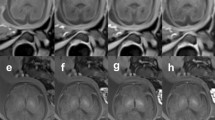Abstract
Objectives
To estimate human fetal brain MRI tissue properties including apparent T1 (T1app) and apparent proton density (PDapp) by using a rapid multi-contrast acquisition protocol called STrategically Acquired Gradient Echo (STAGE) imaging.
Methods
STAGE data were collected using two flip angles (15° and 60°, with a TR = 600 ms) for 30 pregnant women at 1.5 T (15 healthy controls: gestational age (GA) range 19 + 1/7 weeks to 34 + 5/7 weeks; 11 abnormal subjects with ventriculomegaly: GA range 21 + 5/7 weeks to 31 + 5/7 weeks; 4 subjects with other abnormalities). Both T1app and PDapp maps of the fetal brain were calculated from the STAGE data. A region-of-interest-based approach was used to measure T1app and PDapp in the subplate/intermediate zone (SP/IZ), cortical plate (CP), and cerebrospinal fluid (CSF) in the fetal brain.
Results
The ratios of T1appSP/IZ/T1appCP and PDappSP/IZ/PDappCP were larger than unity while T1appSP/IZ/T1appCSF and PDappSP/IZ/PDappCSF were both less than unity.
Conclusions
STAGE imaging provides a potential practical approach to estimate multi-parametric properties of the human fetal brain.
Key Points
• STAGE is feasible in measuring fetal brain tissue properties.
• Water content in cortical plate and subplate/intermediate zone approaches that of cerebrospinal fluid in early gestational ages.





Similar content being viewed by others
Abbreviations
- CP:
-
Cortical plate
- CSF:
-
Cerebrospinal fluid
- GA:
-
Gestational age
- HASTE:
-
Half-Fourier single shot turbo spin echo
- SP/IZ:
-
Subplate/intermediate
- STAGE:
-
Strategically acquired gradient echo
- VM:
-
Ventriculomegaly
References
Girard N, Raybaud C, Poncet M (1995) In vivo MR study of brain maturation in normal fetuses. AJNR Am J Neuroradiol 16:407–413
Wang Z, Chen J, Qin Z, Zhang J (1998) The research of myelinization of normal fetal brain with magnetic resonance imaging. Chin Med J (Engl) 111:71–74
Garel C, Chantrel E, Elmaleh M, Brisse H, Sebag G (2003) Fetal MRI: normal gestational landmarks for cerebral biometry, gyration and myelination. Childs Nerv Syst 19:422–425
Barkovich AJ (2000) Concepts of myelin and myelination in neuroradiology. AJNR Am J Neuroradiol 21:1099–1109
Dubois J, Dehaene-Lambertz G, Kulikova S, Poupon C, Huppi PS, Hertz-Pannier L (2014) The early development of brain white matter: a review of imaging studies in fetuses, newborns and infants. Neuroscience 276:48–71
Holland BA, Hass DK, Norman D, Brant-Zawadzki M, Newton TH (1986) MRI of normal brain maturation. AJNR Am J Neuroradiol 7:201–208
Almajeed AA, Adamsbaum C, Langevin F (2004) Myelin characterization of fetal brain with mono-point estimated T1-maps. Magn Reson Imaging 22:565–572
Cercignani M, Dowell NG, Tofts P (2018) Quantitative MRI of the brain: principles of physical measurement, 2nd edn. CRC Press Taylor & Francis Group, Boca Raton
Chen YS, Liu SF, Wang Y, Kang Y, Haacke EM (2018) STrategically Acquired Gradient Echo (STAGE) imaging, part I: creating enhanced T1 contrast and standardized susceptibility weighted imaging and quantitative susceptibility mapping. Magn Reson Imaging 46:130–139
Wang Y, Chen YS, Wu DM et al (2018) STrategically Acquired Gradient Echo (STAGE) imaging, part II: correcting for RF inhomogeneities in estimating T1 and proton density. Magn Reson Imaging 46:140–150
Haacke EM, Chen YS, Utriainen D et al (2020) STrategically Acquired Gradient Echo (STAGE) imaging, part III: technical advances and clinical applications of a rapid multi-contrast multi-parametric brain imaging method. Magn Reson Imaging 65:15–26
Haacke EM, Brwon RW, Thompson MR, Venkatesan R (1999) Magnetic resonance imaging: physical principles and sequence design, 1st edn. Wiley-Liss, New York
Deoni SC, Rutt BK, Peters TM (2003) Rapid combined T1 and T2 mapping using gradient recalled acquisition in the steady state. Magn Reson Med 49:515–526
Loughna P, Chitty L, Evans T, Chundleigh Y (2009) Fetal size and dating: charts recommended for clinical obstetric practice. Ultrasound 17:160–166
Jones RA, Palasis S, Grattan-Smith JD (2004) MRI of the neonatal brain: optimization of spin-echo parameters. AJR Am J Roentgenol 182:367–372
Yadav BK, Sun TT, Qu FF, Haacke EM, Jiang L, Qian ZX (2019) Cerebral venous oxygenation in the human fetuses with enlarged-ventricles using QSM. In: Proceedings of the Joint Annual Meeting ISMRM-ESMRMB. Montreal, Canada 1643
Leviton A, Gilles F (1996) Ventriculomegaly, delayed myelination, white matter hypoplasia, and “periventricular” leukomalacia: how are they related? Pediatr Neurol 15:127–136
Funding
The authors state that this work has not received any funding.
Author information
Authors and Affiliations
Corresponding authors
Ethics declarations
Guarantor
The scientific guarantor of this publication is Dr. E. Mark Haacke.
Conflict of interest
E. M. Haacke is the Chief Scientific Officer of SpinTech.
Statistics and biometry
One of the authors has significant statistical expertise.
Informed consent
Written informed consent was obtained from all subjects (patients) in this study.
Ethical approval
Institutional Review Board approval was obtained.
Methodology
• prospective
• experimental
Additional information
Publisher’s note
Springer Nature remains neutral with regard to jurisdictional claims in published maps and institutional affiliations.
Feifei Qu and Taotao Sun are co-first authors.
Supplementary Information
ESM 1
(DOCX 17 kb)
Rights and permissions
About this article
Cite this article
Qu, F., Sun, T., Chen, Y. et al. Fetal brain tissue characterization at 1.5 T using STrategically Acquired Gradient Echo (STAGE) imaging. Eur Radiol 31, 5586–5594 (2021). https://doi.org/10.1007/s00330-020-07618-7
Received:
Revised:
Accepted:
Published:
Issue Date:
DOI: https://doi.org/10.1007/s00330-020-07618-7




